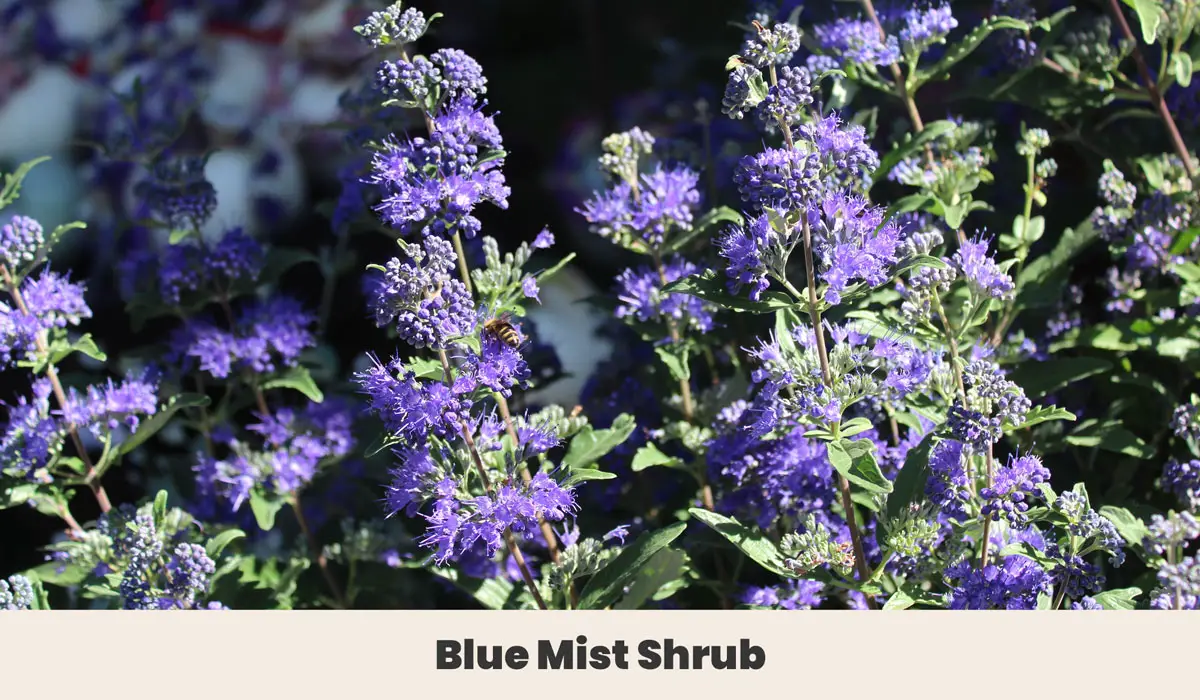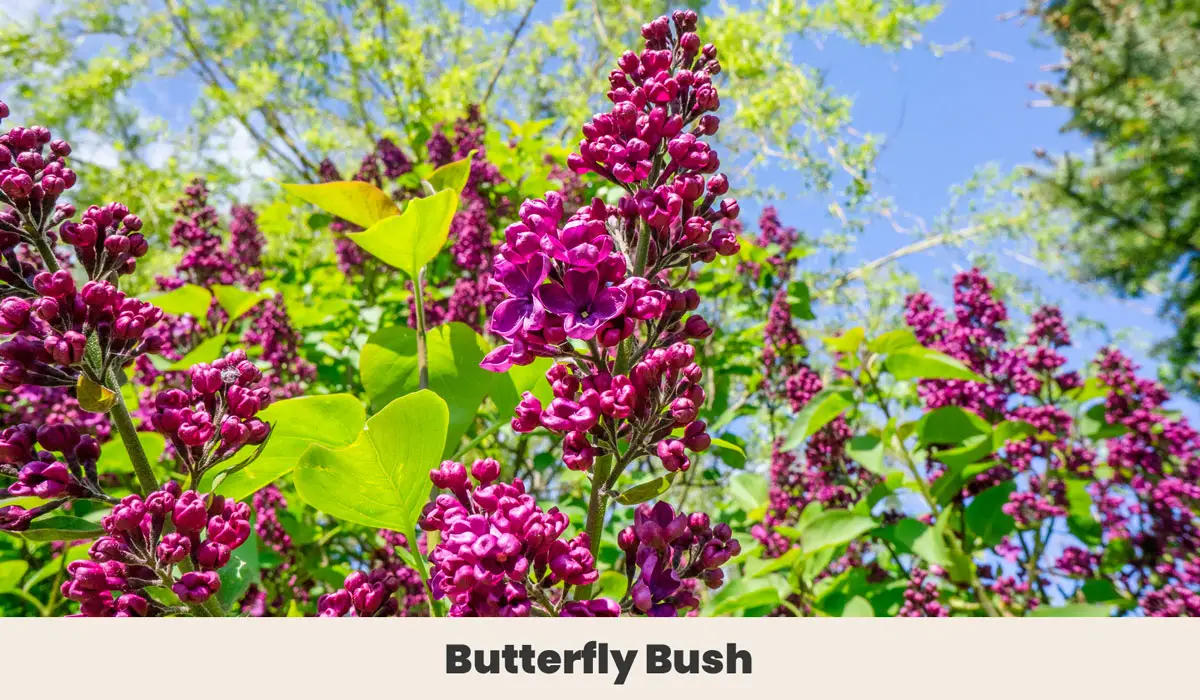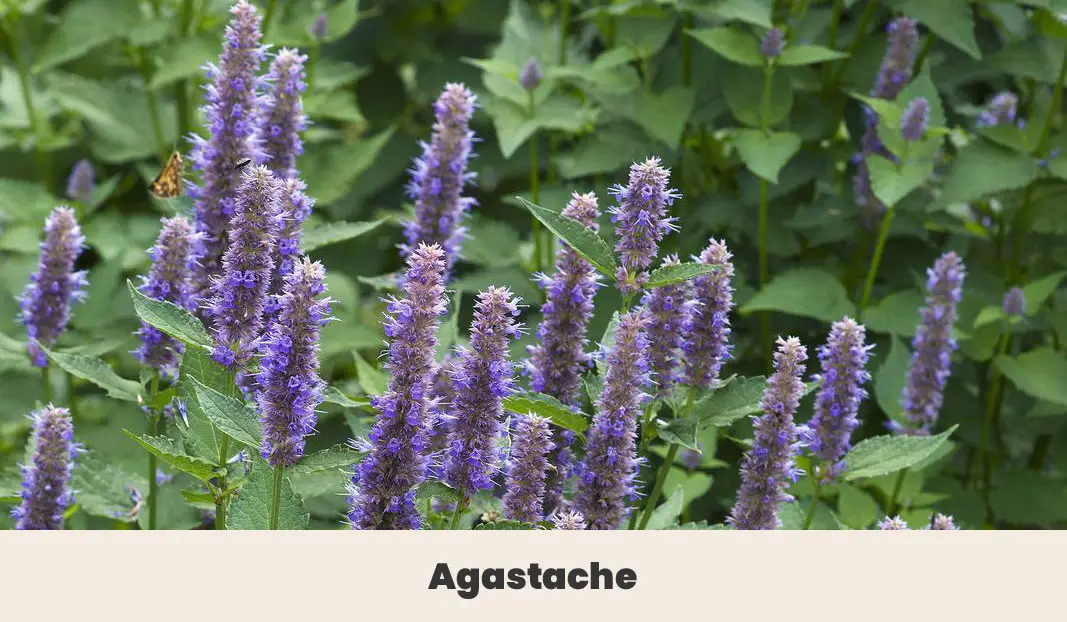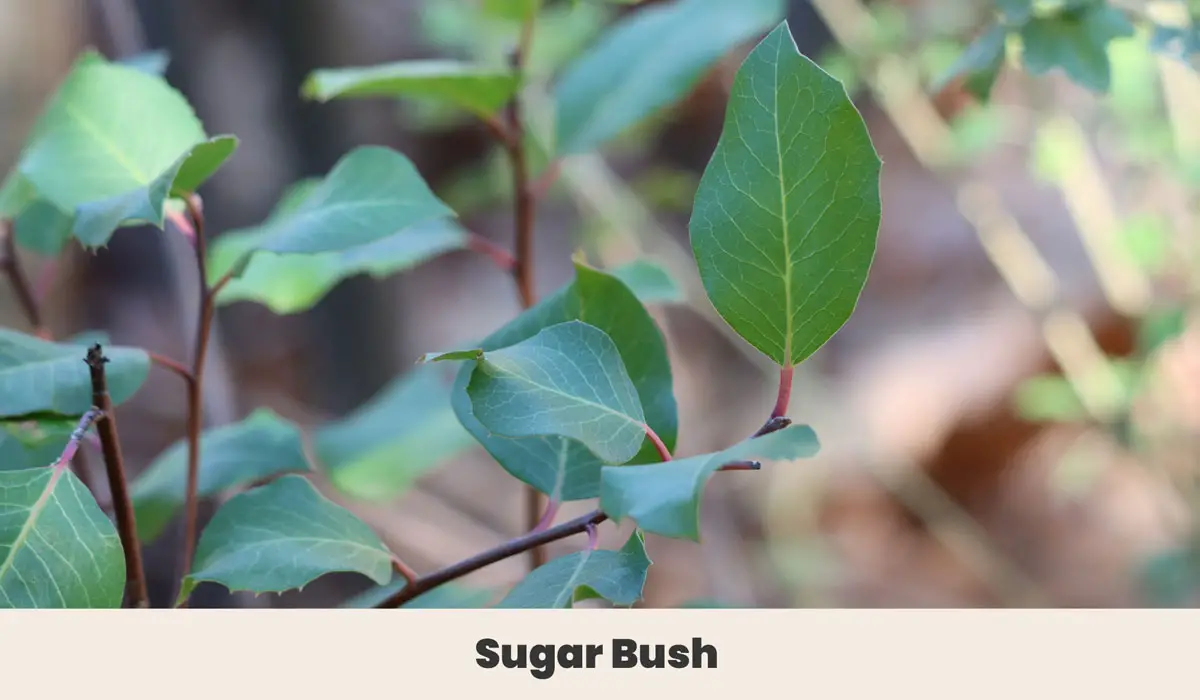11 Drought Tolerant Shrubs to Grow in Warm Climates

This post follows our research editorial guidelines.

Are you looking to add shrubs with red leaves to your garden? What about plants that have fragrant flowers? Or those that have pretty white flowers? If so, look no further than these plants.
Everything on this list is extremely drought resistant and are all relatively easy to care for. If you’re like me and are conscious about your footprint and want to reduce your water intake to help preserve our ecosystem, then these plants are great options.

Many of these flowers bloom between late spring to early fall and look great in small spaces, as hedges, or as borders around your garden. Here’s everything you need to know about these plants:
Quickly Find The Drought Tolerant Shrub Your Looking For
1. Blue Mist Shrub (Caryopteris)

This is a highly drought-tolerant shrub. In fact, you rarely have to water it. The only time you should do so is when the ground is extremely dry and the weather is extremely hot.
It’s because of this that the blue mist shrub is very easy to care for. Plus, thanks to its fragrant purple flowers, it makes for the perfect addition to your landscape.
Here’s everything you need to know about taking care of this flowering shrub:
| Botanical Name: | Caryopteris |
| Growth Rate: | 18-30′ long and 3′ tall |
| Native Range: | Asia |
| Hardiness Zones: | 5-9 |
| Soil Needs: | Moist, well-draining soil |
| Exposure: | Partial shade or full sun |
| Blooming Period: | Early – late summer |
| Water needs: | Water when the ground is dry |
2. Burning Bush (Euonymus Alatus)

Talk about a showstopper! The burning bush is aptly named because of its large fiery red leaves. Though the burning bush can survive in dry conditions, it really prefers to be exposed to sunlight.
Spending too much time in the shade will result in less vibrant leaves – and considering this is what makes this plant so unique, this is something to avoid.
Thinking about adding this to your landscape? Here’s how to take care of it:
| Botanical Name: | Euonymus Alatus |
| Growth Rate: | 6-12′ tall |
| Native Range: | Russia and Asia |
| Hardiness Zones: | 3-9 |
| Soil Needs: | Well-draining soil |
| Exposure: | Partial or full sun |
| Blooming Period: | May – June |
| Water needs: | Water twice a week until roots are established |
3. Butterfly Bush (Buddleja)

With its pretty purple flowers and honey-like scent, it’s no wonder why butterflies want to hang out on the aptly named butterfly bush!
Butterfly bushes are one of the best drought-tolerant shrubs to add to your landscape, not just for pollination reasons but because of how tall they get. The average butterfly bush can get to be up to 12 feet tall. Flowers appear anytime between late summer and fall.
The butterfly bush is a great way to add color to your garden. Here’s everything you need to know about this low-maintenance shrub:
| Botanical Name: | Buddleja |
| Growth Rate: | 6-12′ tall |
| Native Range: | China |
| Hardiness Zones: | 5-10 |
| Soil Needs: | Moist and fertile, well-draining soil |
| Exposure: | Full sun |
| Blooming Period: | Late summer to fall |
| Water needs: | Water once a week |
4. Heavenly Bamboo (Nandina)

Heavenly bamboo is a common evergreen shrub that has red leaves and red berries from flowers that appear in the fall. However, be mindful that the berries this plant produces can be very dangerous if ingested.
However, the plant itself is very attractive to pollinators. It’s usually best planted as a garden border and is pretty drought-resistant.
Once the roots are established, heavenly bamboo can tolerate a dry spell, only needing water occasionally.
Here’s a helpful care guide on how to take care of this green foliage:
| Botanical Name: | Nandina |
| Growth Rate: | 5-7′ tall |
| Native Range: | Asia |
| Hardiness Zones: | 6-9 |
| Soil Needs: | Well-draining soil |
| Exposure: | Partial shade and full sun |
| Blooming Period: | Late spring – early summer |
| Water needs: | Water once a week until roots are established |
5. Barometer Bush (Leucophyllum Frutescens)

Also commonly referred to as a Texas sage plant, the barometer bush has thick purple flowers. It’s also a perennial, which means that it will bloom several times during its life cycle.
In terms of the best drought tolerant shrubs to add to your garden, the barometer bush is really one of the best. It requires little to no work, including watering every 2-3 weeks.
While it doesn’t require pruning, you’re welcome to do so if you want to keep it looking trim. Likewise, you can propagate it any time of year.
Learn more about this plant that is native to North America below:
| Botanical Name: | Leucophyllum Frutescens |
| Growth Rate: | 5-8′ tall |
| Native Range: | Texas and Mexico |
| Hardiness Zones: | 8-10 |
| Soil Needs: | Well-draining soil that has medium moisture |
| Exposure: | Full sun |
| Blooming Period: | Summer-fall |
| Water needs: | Water every 2 – 3 weeks in the summer and once a month in the winter season |
6. Safari Sunset Conebush (Leucadendron)

Known for its bright red leaves, the safari sunset conebush produces small growth in the spring.
If you want to prune the plant, it’s recommended that you do so in late spring once the flowers have fully bloomed. This will keep it trim and prevent overgrowth.
The best thing about the safari sunset conebush is that it makes a great hedge. Learn more about how to take care of this drought-resistant plant below:
| Botanical Name: | Leucadendron |
| Growth Rate: | 3-6′ tall but can grow up to 10′ |
| Native Range: | South Africa |
| Hardiness Zones: | 9-11 |
| Soil Needs: | Well-draining soil |
| Exposure: | Full sun |
| Blooming Period: | Spring |
| Water needs: | Once a week |
7. Yellow Variegated Coast Rosemary (Westringia fruticosa)

The yellow-variegated coast rosemary plant grows between 4 to 6 feet tall. Overall, this is another drought-tolerant shrub that requires minimal care to thrive. It’s generally very resistant to both pests and diseases.
While this can be added to your garden as is, many people tend to use this as a hedge. If you opt for this, then you’ll want to regularly prune it to help keep its shape. Otherwise, only cut leafy growth in the spring and early summer months.
Here’s a helpful overview about how to care for these white clusters of flowers that bloom all year long:
| Botanical Name: | Westringia fruticosa |
| Growth Rate: | 4-6′ tall |
| Native Range: | Australia |
| Hardiness Zones: | 9-10 |
| Soil Needs: | Light, well-draining soil mixed with peat moss |
| Exposure: | Full sun and partial shade |
| Blooming Period: | Year round |
| Water needs: | Water once a week |
8. Agastache (Anise Hyssop)

The agastache plant prefers to grow in fertile, well-draining soil; it will not do well if it’s planted in heavy soil. This is because heavy soil makes it difficult for the plant’s roots to get established, which can lead to diseases such as root rot.
Mabt gardeners like to add agastache to their garden because it’s a perennial and a pretty hardy one at that. It also commonly attracts birds, butterflies, and other pollinators.
Once the roots of this plant are established, you can stop watering it. The agastache plant can still thrive in extreme drought conditions.
Here’s what you need to know about this plant:
| Botanical Name: | Anise Hyssop |
| Growth Rate: | Up to 2-4′ tall |
| Native Range: | The Great Plains and Canada |
| Hardiness Zones: | 3-8 |
| Soil Needs: | Fertile, well-draining soil |
| Exposure: | Full sun and partial shade |
| Blooming Period: | Early summer – fall |
| Water needs: | Water once a week for the first 4 weeks until established |
9. Sugar Bush (Rhus ovata)

Native to both Arizona and California, the sugar bush has arching branches that develop flowers in the spring. This plant has a high drought tolerance, which is why many West Coast gardeners love to add it to their gardens.
A sugar bush plant does need to technically be pruned to thrive, but it should only be done to remove dead leaves by hand, never shears. It doesn’t respond well to heavy pruning. As long as you keep this in mind, you shouldn’t;t run into any issues with these hardy shrubs.
Check out this helpful guide on how to take care of this plant even in hot temperatures:
| Botanical Name: | Rhus ovata |
| Growth Rate: | 8-12′ tall |
| Native Range: | Arizona and California |
| Hardiness Zones: | 7-11 |
| Soil Needs: | Well-draining soil |
| Exposure: | Full or partial sun |
| Blooming Period: | Spring |
| Water needs: | Water once a week when newly planted, then every 2 weeks |
10 Stonecrop (Sedum)

Though the common name for sedum is stonecrop, it may be easier to think of these as succulents. They have the ability to either grow tall and wide or in a cluster that spreads outward across your lawn.
Stonecrop have green leaves and are very hardy. They can survive with little watering once they are established. As long as they’re planted in well-draining soil, this drought resistant plant will do well.
Stonecrop makes a great addition to your landscaping project. Here’s what you need to know about taking care of these:
| Botanical Name: | Sedum |
| Growth Rate: | 1-3′ tall |
| Native Range: | United States |
| Hardiness Zones: | 3-11 |
| Soil Needs: | Well-draining soil |
| Exposure: | At least 6 hours of full sun per day |
| Blooming Period: | Early summer – fall |
| Water needs: | Once established, water until the top layer of soil feels moist |
11. Catnip (Nepeta)

If you’re a cat owner, then you’re probably already familiar with what catnip is. However, did you know that it’s also a plant gardeners love planting on their property? One big reason why is because they attract pollinators, which can help your garden thrive.
The other reason is that catnip plants actually deter bugs from your vegetables. Here’s everything you need to know about this drought-resistant shrub:
| Botanical Name: | Nepeta |
| Growth Rate: | 24-36″ tall |
| Native Range: | Iran |
| Hardiness Zones: | 4-8 |
| Soil Needs: | Well-draining soil |
| Exposure: | Full sun |
| Blooming Period: | Late spring – early fall |
| Water needs: | Apply 1″ of water during the growing season, then once every 3 weeks |
Final thoughts
When it comes to interesting plants that can withstand dry conditions, these are some of the best options available to you.
Many of these plants are native to areas that have hot and dry conditions, so they can go without water for quite some time, meaning less work for you in terms of maintaining them.
Whether you want to see some pretty yellow flowers, blue flowers, or flowers that attract birds and butterflies, this list covers them all. With this guide, you’ll be well on your way to helping them thrive in your garden!

Before you go!
11 Plants With Heart-Shaped Leaves
11 Climbing Plants & Flowering Vines That Love Shade
11 Trees with Heart Shaped Leaves
How to Keep Your Greenhouse Cool in the Summer?